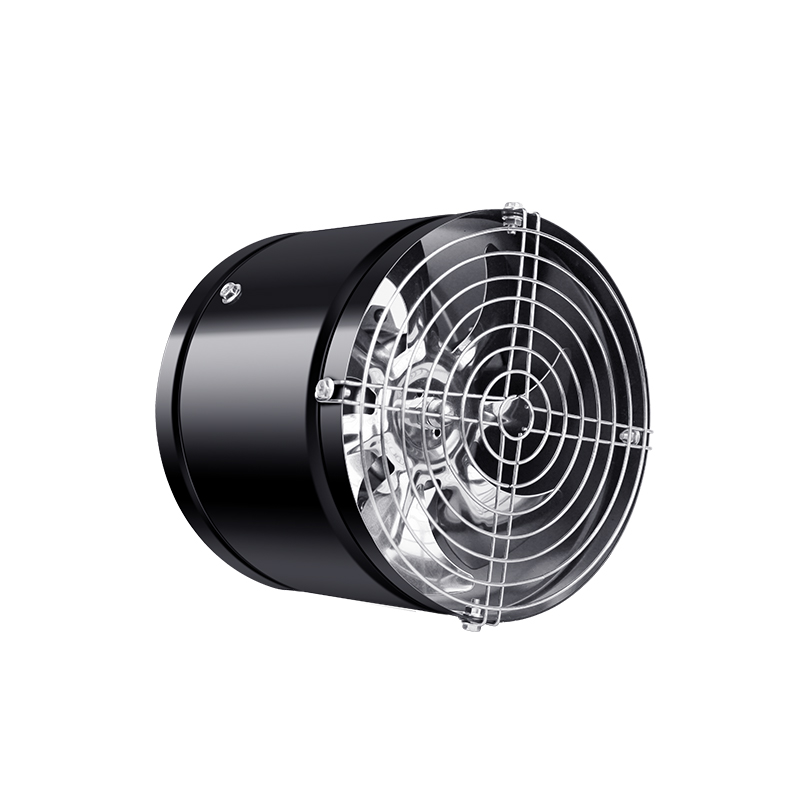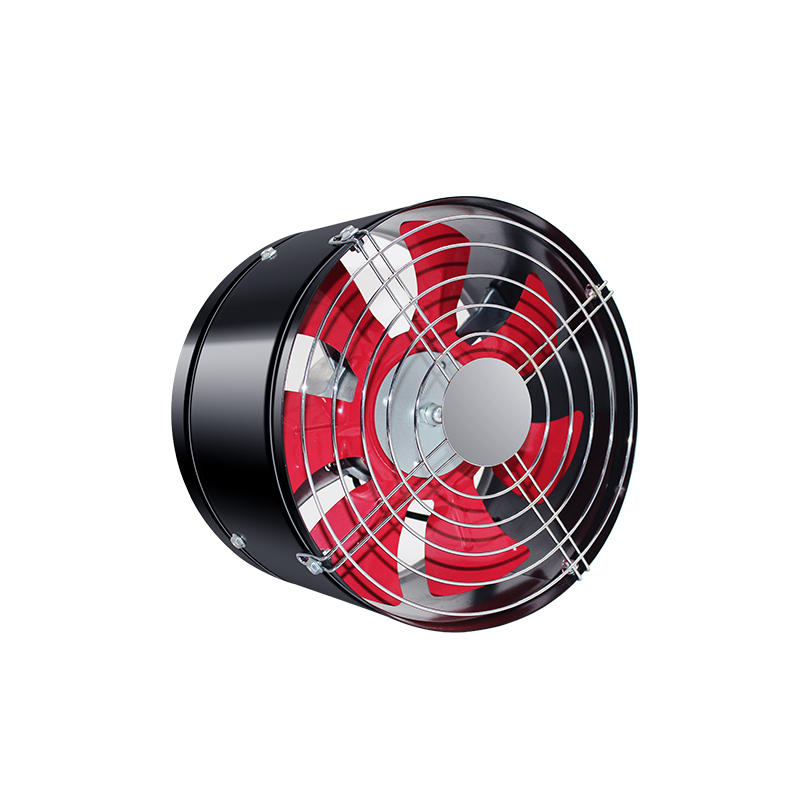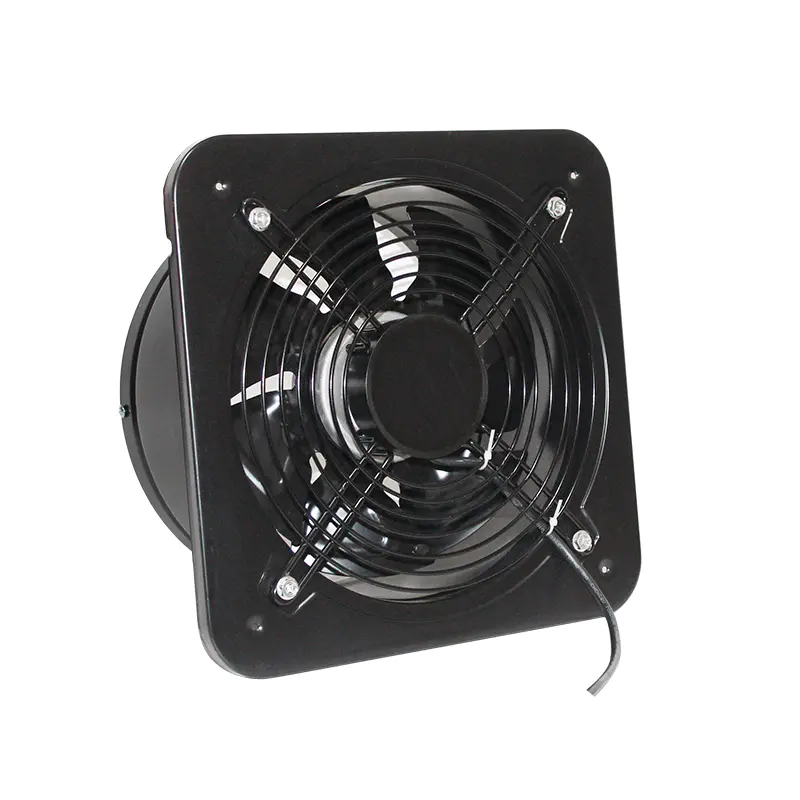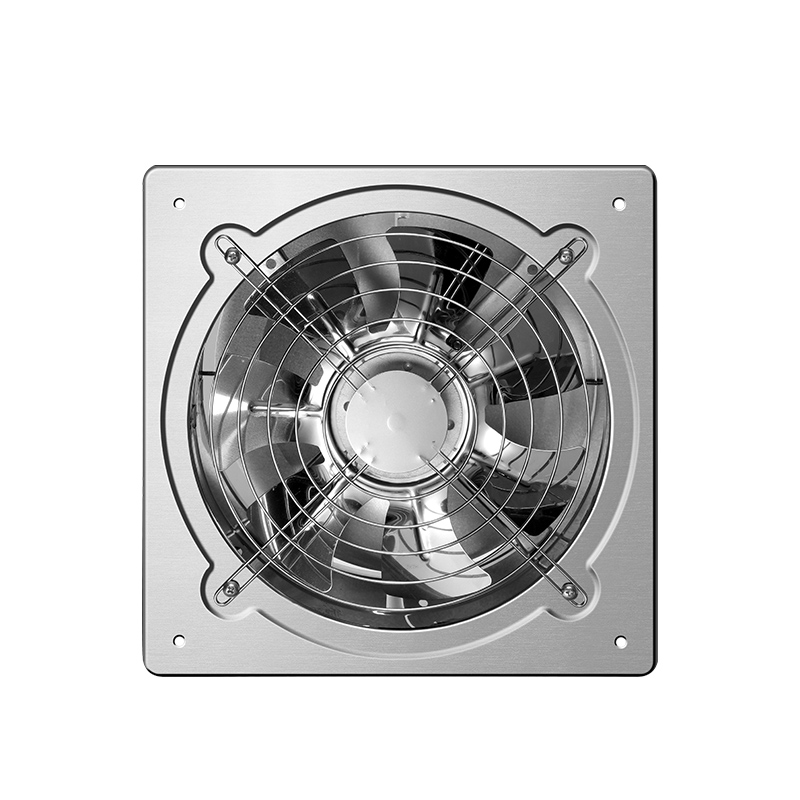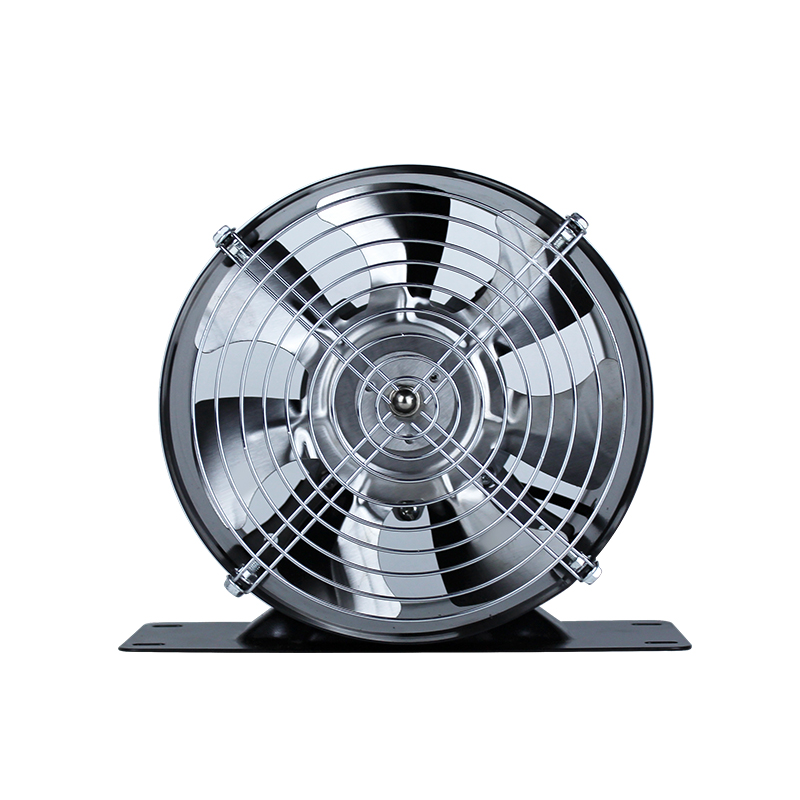News
A Complete Guide to Duct Ventilation Fans: Selection, Installation and Maintenance
- 1 Why Choose Ducted Ventilation?
- 2 Types and Technology of Ducted Ventilation Fans
- 3 How to Choose the Right Ducted Ventilation Fan? – Key Performance Indicators Explained
- 4 Core Application Scenarios: Ventilation Solutions from Shengzhou Qiantai Electric Appliance Co., Ltd.
- 5 5.1 Installation Key Steps
Why Choose Ducted Ventilation?
In modern architectural design, creating a healthy, comfortable, and energy-efficient indoor environment has become a top priority. Whether it's a humid bathroom, a grease-filled kitchen, or an entire home requiring continuous air exchange for fresh air, an efficient ventilation system plays a crucial role. While traditional ceiling or wall-mounted exhaust fans can solve problems to some extent, they often fall short when faced with longer exhaust distances, more complex spatial layouts, or higher demands for quiet operation. This is where a more powerful and flexible solution – ducted ventilation fans – stands out.
Energy-Saving Silent Duct Fan Inline Duct Fan
1.1 What is a Ducted Ventilation Fan?
A ducted ventilation fan, as the name suggests, is a fan designed to be installed inside a ventilation duct system. Unlike traditional fans directly mounted on ceilings or walls, its main body is completely hidden within the ducts, typically placed in attics, ceiling plenums, or equipment rooms.
-
Other Names: In the industry and market, you might also hear it referred to by other names, such as Duct Fan or the more descriptive Inline Fan. These terms all refer to the same product.
-
Core Function: Its fundamental task is to provide powerful airflow, solving long-distance, high-resistance air movement problems. When air needs to travel through curved, lengthy ducts to be expelled outdoors, or needs to be distributed from a central point to multiple rooms, a ducted fan can overcome the air resistance (i.e., "static pressure") generated during this process. This ensures sufficient airflow at the end of the duct outlets or inlets, achieving precise and efficient air exchange.
Imagine it as the "heart" of your home's ventilation system, providing a continuous source of power to the entire duct network, "pumping" stale, humid air out and drawing fresh air in.
1.2 Core Advantages of Ducted Ventilation
Choosing a ducted ventilation system means opting for a solution that excels in performance, comfort, and aesthetic design. Its core advantages are primarily reflected in the following aspects:
-
High Efficiency & Power
The airflow of traditional exhaust fans rapidly diminishes when encountering ducts longer than one or two meters or one or two bends. Ducted fans, however, are specifically designed to overcome high static pressure. Even in complex duct systems dozens of meters long and containing multiple bends, they can maintain strong airflow, ensuring that bathroom humidity and kitchen grease are thoroughly expelled, leaving no lingering issues. -
Flexibility & Aesthetics
Since the fan's main body is cleverly "hidden," what you see in the indoor space are only one or more simply designed grilles at the air intake/outlet that can blend seamlessly with your interior decor. This provides designers and homeowners with great freedom, eliminating the need to reserve space for bulky fan units on walls or ceilings, thereby maintaining indoor neatness and aesthetics. -
Ultra-Quiet Operation
This is one of the most popular advantages of ducted fans among users. Because the main sources of noise – the fan motor and blades – are installed far from your main living areas (like bedrooms, studies) in the attic or deep within the ceiling plenum, and are physically isolated by the ducts. You will barely hear any mechanical humming in the room; you will only perceive air quietly moving. This "feel the breeze, no visible fan, no audible sound" experience greatly enhances living comfort and tranquility. -
"One-to-Many" Centralized Ventilation Capability
For scenarios requiring simultaneous ventilation for multiple areas, the advantages of ducted fans are particularly prominent. A sufficiently powerful ducted fan can connect the exhaust vents of both the master and guest bathrooms, or set up multiple suction points for a large open-plan space, all through branched ducts. This centralized solution not only simplifies the system and reduces installation and maintenance complexity but is also more cost-effective than installing a separate fan for each area.
Types and Technology of Ducted Ventilation Fans
Understanding the different technologies and designs of ducted ventilation fans is the first step in making the right choice. The market offers a wide array of products, but from a core technology perspective, we can primarily classify them along two dimensions: first, the "heart" that drives them – the motor technology; and second, the "wings" that determine their performance characteristics – the impeller (fan blade) design. Understanding these differences will help you precisely match your specific needs. For example, when you're searching for " silent inline fan recommendations for home use," the motor type will be crucial.
2.1 Classification by Motor Technology: AC vs. DC/EC
The type of motor directly determines the fan's energy efficiency, controllability, and operational lifespan.
-
Alternating Current (AC) Motor Fans
This is a very traditional and mature technology. AC motors directly use standard household alternating current to drive the fan's rotation.- Characteristics: Widely adopted technology, relatively low manufacturing cost, leading to more competitively priced products. They have a simple and robust structure.
- Applicable Scenarios: For regular applications with infrequent use and no extreme demands for energy consumption or noise control, AC fans are a cost-effective choice, such as for occasional use in a guest bathroom exhaust.
-
Direct Current (DC) / Electronically Commutated (EC) Motor Fans
DC (Direct Current) motor fans represent a significant technological advancement. They convert input AC power into DC power, either through a built-in or external power adapter, to drive the motor. EC (Electronically Commutated) motors are a more advanced form of DC motor, utilizing internal smart electronic modules for control, achieving a perfect blend of efficiency and performance.- Characteristics: The core advantage of EC/DC fans lies in their superior energy efficiency. Wondering " how effective are DC EC inline fans for energy saving"? They typically save 30% to 70% more energy than AC fans of equivalent airflow. Additionally, they operate extremely quietly and can easily achieve precise, stepless speed control (0-100%), unlike AC fans which usually only have a few fixed speeds. A longer design life is also a significant benefit.
- Applicable Scenarios: Suitable for almost all applications, especially those requiring long-term continuous operation (e.g., whole-house ventilation systems), stringent noise requirements (e.g., bedrooms, studies), and a desire to maximize long-term electricity cost savings. For users seeking high quality and long-term returns, EC fans are undoubtedly the top choice.
Parameter Comparison: AC Motor vs. DC/EC Motor
| Characteristic | Alternating Current (AC) Motor Fan | Direct Current (DC) / Electronically Commutated (EC) Motor Fan |
|---|---|---|
| Energy Efficiency | Standard | Extremely High, significant electricity savings |
| Operating Cost | Higher | Very Low |
| Speed Control | Limited (usually high/medium/low or single speed) | Precise Stepless Speed Control (0-100%) |
| Noise Level | Moderate | Very Quiet, especially at low speeds |
| Initial Cost | Lower | Higher |
| Lifespan | Standard | Longer |
| Intelligence | Limited | Easy to integrate sensors and smart controls |
| Recommended Application | Budget-limited, intermittent use scenarios | Applications with high demands for performance, quietness, and energy saving |
2.2 Classification by Impeller (Fan Blade) Design
The geometric shape of the fan blades determines how the fan moves air, directly affecting its airflow volume and its ability to overcome resistance (static pressure).
-
Axial Fans
This is the most common design, where the air enters and exits parallel to the fan's axis of rotation, much like an airplane propeller.- Characteristics: Capable of moving large volumes of air (high airflow) at low resistance, but their ability to generate pressure (static pressure) is very limited. Their performance rapidly declines as ducting gets longer or includes bends.
- Applicable Scenarios: Primarily used for "point-to-point" ventilation in short, straight ducts, or as wall-mounted or window-mounted exhaust fans. Not suitable for complex duct systems.
-
Centrifugal Fans
Centrifugal fans are often referred to as "squirrel cage" fans. Air is drawn in axially from the center, then propelled outwards (radially) by the high-speed rotating impeller, finally exiting through the fan's volute casing.- Characteristics: The biggest advantage of this design is its ability to generate very high static pressure. This makes it an ideal choice for overcoming high-resistance duct systems such as long distances, multiple bends, or those with filters. When considering " high static pressure centrifugal inline fan selection," its performance curve is particularly crucial. However, its structure is typically larger than that of an axial fan.
- Applicable Scenarios: Commercial kitchen exhaust, complex ventilation systems connecting multiple rooms, and any industrial or commercial environment requiring "powerful air pushing."
-
Mixed-Flow Fans
Mixed-flow fans are the "culmination" of modern inline fan technology, cleverly combining both axial and centrifugal principles. Air flows diagonally through the impeller.- Characteristics: They achieve a perfect balance in performance, providing significantly higher static pressure than pure axial fans while maintaining large airflow volumes close to axial fans. At the same time, their bodies are more compact and operate more quietly than centrifugal fans of equivalent performance. This makes the answer to the question " which is better, mixed-flow or centrifugal fan," lean towards mixed-flow for most residential and light commercial applications.
- Applicable Scenarios: This is currently the most mainstream and versatile choice for residential and light commercial applications. Whether for bathroom dehumidification, auxiliary kitchen exhaust, or whole-house ventilation systems, mixed-flow fans deliver efficient, quiet, and reliable performance.
Parameter Comparison: Axial vs. Centrifugal vs. Mixed-Flow
| Type | Airflow Capacity | Static Pressure Capability (Overcoming Resistance) | Size/Structure | Noise Level | Recommended Application Scenarios |
|---|---|---|---|---|---|
| Axial | Large | Low | Compact | Moderate | Short, straight, low-resistance ducts |
| Centrifugal | Medium | Very High | Larger, bulky | Higher | Long-distance, multi-bend, high-resistance systems |
| Mixed-Flow | Large | High | Compact | Low | Most residential and light commercial applications |
How to Choose the Right Ducted Ventilation Fan? – Key Performance Indicators Explained
Selecting an inline fan isn't just about brand and price; more importantly, it's about understanding its performance parameters. Only by grasping the meaning behind these numbers can you ensure that the product you buy truly solves your problem instead of being an expensive "decoration." Incorrect selection can lead to insufficient airflow, excessive noise, or wasted energy. Here are five crucial indicators you must master when making your decision.
3.1 Airflow (CFM / m³/h)
Airflow is the most fundamental indicator of a fan's performance, representing the volume of air the fan can move per minute (CFM - Cubic Feet per Minute) or per hour (m³/h - cubic meters per hour). Insufficient airflow will significantly compromise ventilation effectiveness; excessive airflow may lead to unnecessary energy waste and noise.
- Definition: The total volume of air passing through the fan per unit of time.
- How to calculate your needs?
-
Method 1: By Air Changes per Hour (ACH) (More Precise)
This is an internationally recognized standard calculation method, especially suitable for spaces with high air quality requirements. The formula is:
Required Airflow (m³/h) = Room Volume (Length × Width × Height, in meters) × Recommended Air Changes per Hour (ACH)Suggested ACH values for various spaces:
- Bathrooms: 8-10 times/hour (effectively removes moisture and odors)
- Kitchens: 15 times/hour or higher (quickly removes cooking fumes and heat)
- General Living Rooms/Bedrooms: 3-5 times/hour
- Whole-house continuous ventilation: 0.35 times/hour (basic requirement for maintaining healthy air)
For example, for a bathroom 3 meters long, 2 meters wide, and 2.5 meters high, the recommended " bathroom inline fan airflow calculation " process is as follows:
Volume = 3m × 2m × 2.5m = 15 m³
Required Airflow = 15 m³ × 8 ACH = 120 m³/h -
Method 2: Area-based Estimation (Common in North America)
A simplified method suggests that a bathroom needs 1 CFM of airflow per square foot (sq. ft.) of area. For instance, a 100 sq. ft. bathroom would require at least a 100 CFM fan.
-
3.2 Static Pressure (Pa / Inches of Water Gauge)
If airflow determines "how much air can be moved," then static pressure determines "how far and through how many turns it can be moved." This is the most easily overlooked, yet most critical, parameter when choosing an inline fan.
- Definition: Static pressure is the pressure a fan must generate to overcome the internal resistance of the entire ventilation duct system (including duct length, number of bends, filters, outlet grilles, etc.). It can be understood as the "push" force for air moving through the duct.
- Importance: The "maximum airflow" you see on product specifications is measured under ideal conditions with zero static pressure, meaning no ducts connected. In actual installation, as soon as ducts are connected, resistance (static pressure) is generated, and the fan's actual airflow will decrease. If the duct system is long or has many bends, a low-static-pressure fan might ultimately fail to produce any effective airflow at the outlet. This is the root of the question " what to do if inline fan static pressure is insufficient " – the answer is to select a high-static-pressure model before purchasing.
- How to Choose: Professional users should consult the " Fan Performance Curve." This chart shows the actual airflow of the fan at different static pressure levels. You need to estimate the total resistance of your duct system and then refer to the curve to see if the fan can still provide the required airflow at that resistance. For general users, a simple rule of thumb is: the longer the duct and the more bends, the more you need to choose a mixed-flow or centrifugal fan explicitly labeled "high static pressure."
3.3 Noise Level (Sones / Decibels dB)
Nobody wants their peaceful shower interrupted by a loud roar from above. Noise level directly impacts your quality of life.
- Definition: Sone is a unit that correlates better with how the human ear perceives loudness than decibels (dB). A lower value indicates a quieter perceived sound.
- Purchasing Advice: For users seeking a comfortable experience, when making " ultra-quiet inline fan selections," the Sone value should be a core reference.
Sones Noise Level Reference Table
| Sone Value | Roughly Equivalent To | Perception | Applicable Scenarios |
|---|---|---|---|
| < 0.3 | Studio-level quiet | Nearly silent | Bedrooms, studies with extreme quiet requirements |
| 0.3 - 1.0 | A quiet modern refrigerator | Very quiet, barely noticeable | Master bathrooms, living rooms |
| 1.0 - 2.0 | Soft conversation | Quiet, with slight background noise | Regular bathrooms, laundry rooms |
| 2.0 - 4.0 | Office environment | Noticeable noise | Garages, basements, commercial kitchens |
| > 4.0 | Normal speaking volume | Noisy | Industrial environments or places where noise is not a concern |
3.4 Duct Diameter
The fan's opening must match your duct system.
- Common Sizes: The most common sizes in residential applications are 4 inches (100mm) and 6 inches (150mm). Larger sizes typically mean more air can be moved at lower speeds and noise levels.
- Matching Principle: Choose a fan that matches the diameter of your ductwork. For example, if you are installing 6-inch ducts, you should buy a fan with 6-inch ports. You should strongly avoid using reducers (e.g., connecting a 6-inch fan to a 4-inch duct), as this will sharply increase system resistance, leading to a significant drop in airflow and generating additional air noise. When comparing " 4-inch vs. 6-inch inline fans," understand that a 6-inch system is far more efficient at moving air under the same static pressure than a 4-inch system.
3.5 Energy Efficiency Certification
For fans that need to run for extended periods (e.g., whole-house ventilation systems), energy consumption is a long-term cost that cannot be overlooked.
- Look for Certifications: Seek products with the " ENERGY STAR® " certification logo. Fans that earn this certification must meet specific performance standards while being at least 20% more energy-efficient than conventional models.
- Choose EC/DC Motors: As discussed in Part Two, selecting " energy-efficient inline fans " that use EC/DC motors is the most effective way to ensure maximum energy efficiency and minimize long-term operating costs. While the initial investment might be slightly higher, the electricity savings typically recoup the cost within one to two years.
Core Application Scenarios: Ventilation Solutions from Shengzhou Qiantai Electric Appliance Co., Ltd.
Shengzhou Qiantai Electric Appliance Co., Ltd. is located in Shengzhou City, Zhejiang Province, renowned as "the town of Yue opera" and "the town of the motor." Our company is situated at No. 1378 Xianhu Road, Sanjiang Industrial Park. As an enterprise specializing in the design, production, and sale of exhaust fans, ventilation fans, axial fans, industrial fans, and their supporting motors, Shengzhou Qiantai Electric Appliance Co., Ltd.'s products are certified by the China Quality Certification Center and are widely used in exhaust/cooling systems for home kitchens, restaurants, factories, pipelines, warehouses, and more. We boast strong technical force, robust independent innovation capabilities, advanced production and testing equipment, and a perfect management system. We consistently uphold reliable product quality and user experience. Adhering to the "customer first, employees second, shareholders third" philosophy, Shengzhou Qiantai Electric Appliance Co., Ltd. continuously innovates, striving to provide customers with excellent energy-saving products and contribute to the development of China's fan industry. We warmly welcome friends from all walks of life, both domestic and international, to visit us!
4.1 Bathroom Exhaust
Challenge: Common issues in bathrooms include humidity, unpleasant odors, and foggy mirrors. These not only affect user experience but can also lead to mold growth and damage to decor over time. Many households seek a quiet bathroom exhaust fan installation or a ducted bathroom exhaust fan solution.
Solution: Shengzhou Qiantai Electric Appliance Co., Ltd. recommends using mixed-flow fans. These fans combine the high static pressure of centrifugal fans with the large airflow of axial fans, providing powerful ventilation. Installing the fan in the attic or ceiling void, connected to the bathroom's intake vent via flexible or rigid ducts, allows for strong, quiet moisture removal. This effectively solves humidity and odor problems, fulfilling the need for a bathroom anti-fog exhaust fan and making the bathroom a more comfortable space. Our solutions also perfectly fit applications for attic ventilation systems in bathrooms.
4.2 Kitchen Ventilation
Description: Kitchen smoke and heat not only impact the cooking experience but also accumulate on furniture and walls. Beyond traditional range hoods, auxiliary ventilation systems are essential in certain scenarios, especially for kitchens where direct-vent range hood installation isn't feasible. This is crucial for homes seeking a smokeless kitchen ventilation solution.
Solution: Shengzhou Qiantai Electric Appliance Co., Ltd. produces oil-resistant centrifugal or mixed-flow fans that are ideal for this purpose. These fans are specifically designed to handle the complex oil and high-temperature environments of kitchens, effectively removing residual heat, steam, and odors generated during cooking. Whether it's to address kitchen exhaust fan noise or to supplement commercial kitchen ventilation equipment, our fans offer efficient and reliable performance, while also facilitating future kitchen exhaust duct cleaning and maintenance.
4.3 Whole-House Ventilation System
Concept: A whole-house ventilation system is a vital component of modern building health and comfort. It can serve as the core power for HRV/ERV (Heat/Energy Recovery Ventilators) or be used independently for balanced ventilation, achieving highly efficient energy-saving ventilation equipment and seamlessly integrating with smart home air circulation systems.
Solution: Shengzhou Qiantai Electric Appliance Co., Ltd. offers high static pressure, large airflow, and speed-adjustable EC fans. EC (Electronically Commutated) fans are an ideal choice for whole-house ventilation systems due to their high efficiency and precise control. By connecting to supply and return air ducts distributed throughout the entire house, these fans enable continuous, stable fresh air exchange, effectively removing indoor pollutants and improving air quality. For customers concerned about whole-house fresh air system installation costs and the HRV ERV working principle, EC fans are undoubtedly a core component for achieving an efficient balanced ventilation system design.
Parameter Comparison (EC Fans vs. Traditional AC Fans):
| Feature | EC Fans | Traditional AC Fans |
|---|---|---|
| Efficiency | Significantly higher (typically 30% - 50% energy saving) | Lower |
| Noise | Quieter operation | Relatively noisier |
| Speed Control | Supports stepless speed adjustment, precise airflow control | Usually only supports multi-speed settings or requires a frequency converter |
| Lifespan | Longer | Relatively shorter |
| Smart Features | Can be integrated with smart control systems for automated operation and monitoring | Lower level of automation |
| Cost | Initial purchase cost may be slightly higher, but lower long-term operating costs | Lower initial purchase cost, but higher long-term operating costs |
4.4 Other Applications
Shengzhou Qiantai Electric Appliance Co., Ltd.'s fan products are also widely used in the following scenarios:
- Basement/Garage Ventilation: Effectively remove humidity, musty odors, and harmful gases (such as car exhaust) to keep the space dry and clean. Our products offer reliable options for basement moisture control ventilation solutions and garage exhaust fan selection.
- Walk-in Closet/Laundry Room Dehumidification: Prevent clothes and fabrics from becoming damp and moldy, extending their lifespan. We can provide professional walk-in closet dehumidification ventilation and laundry room exhaust systems.
- Equipment Cooling/Server Room Cooling: Provide effective heat dissipation solutions for high-performance equipment, ensuring stable operation and extending equipment lifespan. Our server room cooling fan recommendations can meet stringent industrial demands.
Shengzhou Qiantai Electric Appliance Co., Ltd. is committed to providing innovative ventilation solutions that meet the diverse needs of our customers. Do you have any questions about our products and solutions, or would you like to learn more about our customized services?
5.1 Installation Key Steps
Choosing the right ducted ventilation fan installation location is crucial. The ideal spot should allow for easy inspection and maintenance while ensuring the fan is securely mounted to minimize vibration and noise during operation.
When it comes to fan mounting, use sturdy and reliable brackets to ensure the fan is securely installed. This is critical for reducing ducted ventilation fan noise and extending the equipment's lifespan.
For ducting connections, make sure all joints are well-sealed. You can use high-quality tape or professional clamps for sealing. Additionally, try to keep the ducting as straight as possible, minimizing unnecessary bends. This helps reduce airflow resistance and improves ducted ventilation fan efficiency.
Electrical wiring must strictly follow the product manual and local electrical safety codes. For your safety and the proper functioning of the equipment, it's highly recommended to have a professional electrician handle the wiring to avoid any ducted ventilation fan wiring errors.
For controller installation, you can choose to install a timer, humidity sensor, or speed switch based on your needs. These control devices offer more flexibility in managing ducted ventilation fan operating modes, allowing for both energy savings and comfort.
5.2 Common Installation Mistakes and How to Avoid Them
Here are some common mistakes encountered during ducted ventilation fan installation and methods to avoid them:
- Ducting sagging or being too long, leading to excessive airflow resistance: Ensure proper ducting layout, minimize duct length, and use appropriate supports to prevent sagging. This effectively prevents issues with insufficient ducted ventilation fan airflow.
- Poor sealing leading to air leaks: When connecting ducts, carefully inspect and ensure all joints are tightly sealed. If necessary, use professional sealants or sealing strips to avoid efficiency loss due to ducted ventilation fan air leaks.
- Failure to use acoustic hangers resulting in vibration noise: When installing, it's recommended to use professional acoustic hangers or anti-vibration pads. These effectively absorb vibrations generated by the fan's operation, significantly reducing ducted ventilation fan noise.
5.3 Routine Maintenance and Cleaning
To ensure your ducted ventilation fan operates efficiently for a long time, regular maintenance and cleaning are essential:
- Regularly clean the inlet/outlet grilles: Inlet and outlet grilles tend to accumulate dust and debris. Regular cleaning ensures smooth airflow and improves ducted ventilation fan ventilation effectiveness.
- Depending on the usage environment, regularly check and clean dust and grease from the fan impeller: Humid or greasy environments can lead to significant dust and grease accumulation on the impeller, which can severely impact fan performance or even cause malfunctions. Regularly cleaning the ducted ventilation fan impeller is key to maintaining its efficient operation.
- Check the ducting for damage or blockages: Periodically inspect the inside of the ducting to ensure there are no obstructions or damage. This effectively prevents issues like reduced airflow or unusual noises due to ducted ventilation fan blockages.


 English
English 中文简体
中文简体
